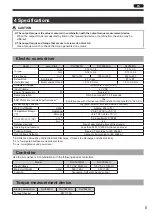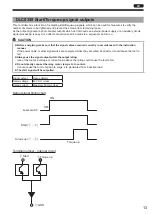
14
EN
7 Appendix
Troubleshooting
Symptoms
Location to investigate
Solution
Controller power won't
turn on.
Is the power plug inserted into an
outlet?
Is the power cord slipped out of the
inlet?
Has the rated voltage been input?
Is the power switch set to OFF (
side)?
Check the power supply.
Firmly insert the power cord, and set the power
switch to ON ( I side).
Has the fuse blown?
If the power lamp does not light up, check the fuse
in the power cord inlet.
If it is blown out, replace it with a fuse provided with
your electric tool.
The electric screwdriver
does not operate.
Is the power plug inserted into an
outlet?
Is power supplied to the outlet?
Properly insert the power plug into the outlet.
Check the power supply.
Is the changeover switch set to
neutral?
Slide the changeover switch to the
or
side.
The output torque is low
Screws cannot be
tightened.
Are you using a combination of
NITTO KOHKI measuring devices for
measurement?
Use a combination of NITTO KOHKI's measuring
devices for measurement. (p. 5)
Are you turning the torque adjustment
ring clockwise?
Has the output torque dropped?
The output torque decreases as the tool is used.
Turn the torque adjustment ring clockwise. (p. 11)
Did you check the correlation between
the output torque occurred on screws
and the output torque measured using
a measurement device?
The output torque occurred on screws and the
output torque measured by the measurement device
are different.
Adjust the output torque according to the screw
fastening conditions. (p. 5)
Is the bit worn out?
When the bit is worn out, it becomes difficult to
transmit torque to screws.
Replace the bit. (p. 7)
Are you tightening while crushing a
part between the screws.
Has regression loosening occurred?
Torque may not be transmitted. Crush the part once
and then tighten the screw.
Has axial force occurred to the screw?
Without axial force, even though the output torque
is increased, screws are not tightened. Review the
screw fastening conditions.
Also, by tightening at low speed, it becomes easier
to transmit torque.
Has initial loosening occurred?
Initial loosening occurs as a result of permanent set
in fatigue when fine irregularities such as surface
roughness are lost over time after the screw is
tightened or outside force is applied. Tighten the
screw again.
Has the permanent set in fatigue
occurred due to permanent
deformation of sealing material such
as the gasket?
Carefully check the screw fastening conditions and
set the output torque.
Depending on the material, torque may not be
transmitted.
Is the area surrounding the screw at a
high temperature?
Screws could be extended or loosened by
temperature changes.
Review the screw fastening conditions and process.
Have you considered the occurrence
of vibration or outside force?
Loosening of screw occurs if no measures are taken
for vibration or outside force.
Take appropriate loosening prevention measures.
TV06941-2̲DLV5800̲en.indb 14
TV06941-2̲DLV5800̲en.indb 14
2019/08/19 11:04:22
2019/08/19 11:04:22




































